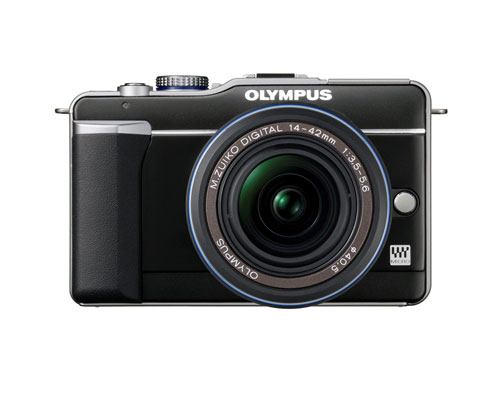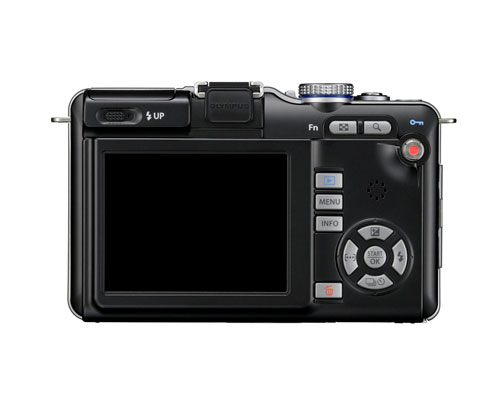Best Bargain Mirrorless Cameras
- Shootout
- Olympus PEN E-PL1
- Samsung NX10
- Olympus PEN E-PL2
- Buyer's Advice and Conclusion
Olympus PEN E-PL1
At under $300, the Olympus E-PL1 is a great bargain camera. This unassuming little camera uses a micro four thirds sensor that will beat the pants off of any point and shoot, but it currently sells for less than three hundred dollars with a lens. Released in early 2010, the E-PL1 has lackluster video capabilities and a non-articulating screen. It also lacks a control wheel, which makes adjusting the settings a touch more difficult. Overall, though, it takes wonderful photos for the price.

The Good
Large sensor. The E-PL1 has a 12.3 megapixel Micro Four Thirds sensor, much larger than the sensors found in both superzoom and point-and-shoot cameras. In general, this means you'll see less noise at a given ISO setting, better low-light performance, better control over depth of field, and sharper, clearer images from the E-PL1 than from any of those cameras. Our test photos show the kind of detail that you can expect from this camera.
Extensive controls. Another major advantage over point-and-shoot cameras is the ability to adjust almost anything. One of the biggest differences between snapshot cameras and serious cameras, besides the presence of a viewfinder, is how much control the camera gives you over how a picture is taken. Of course, if that sounds like a lot of work you'd rather not do, the E-PL1 also has an "auto" mode just like any other camera.
Great lens selection. Olympus has been at the mirrorless camera game longer than anyone else, and they've built up an impressive array of lenses. At this point, Olympus has zoom lenses to cover just about every useful focal length from 9mm to 300mm (though obviously not all in the same lens). In addition to Olympus's own line, the E-PL1 is also compatible with most Panasonic Micro Four Thirds lenses.
In-body image stabilization. Every camera manufacturer has some sort of image stabilization, but they can differ in their implementation. While most camera makers put image stabilization in the lens, Olympus puts it in the camera body. There are a few advantages to this, the biggest one being that every lens can take advantage of image stabilization, even old manual-focus 35mm lenses from the eighties (provided you have the right adapter, of course). The downside is that, for optimum performance, you have to dig into the camera's menu and specify the focal length of the lens you're using.
The Bad
Low light. Newer cameras have more extensive ISO ranges, and therefore better low-light performance, than the E-PL1. Noise reduction on point-and-shoot cameras has gotten very good in the past few years, and newer mirrorless cameras are better still. The E-PL1 can go up to ISO 3200, which is relatively low these days.
Non-articulating small screen. LCD screens as viewfinders typically work well until there is a bright light source at your back. Typically, this is mitigated by tilting the screen or using the eye-level finder, but the E-PL1's screen does not tilt and the camera does not include an eye-level finder. The VF-2 accessory finder ($220) adds to the price of the camera, but if you plan on doing a lot of shooting in bright sunlight, it is a worthwhile investment. There's also the VF-3 finder, which is lower in resolution but also lower in price at $180.

Larger than latest generation. The PL1 with attached lens is larger than today's mirrorless cameras like some of the smaller Panasonic or Sony mirrorless models. And if you're going to use the E-PL1 as your every-day camera, you will find it less convenient than a pocketable point-and-shoot. But it is still smaller than a typical DSLR, so size is relative.
Limited movies. The E-PL1 records in the Motion JPG format at either 1280x720 HD or 640x480 SD resolution. The Motion JPG format is easy for most editing programs and computers to understand, but it is also inefficient. What's more, the E-PL1 cannot create a video file larger than 2GB, regardless of the size of your SD card, while most cameras can go up to 4GB. In HD, this translates into 7 minutes; in SD, the limit is 14 minutes.
Lacks a control wheel. Almost all serious cameras have a control wheel of some kind, allowing the user to quickly scroll through settings. This is useful when changing aperture and shutter speed especially, but it also works to switch through a camera's scene modes or flip through pictures you've already taken. The E-PL1 does not have such a wheel, while most other (admittedly newer) mirrorless cameras do. Instead, changing aperture or shutter speed is a matter of repeatedly clicking a button to reach the desired value. This takes more time and makes it harder to adjust your camera on the fly. However, people coming from point-and-shoot cameras might never notice--especially if they stay in Program mode.
The Verdict
The E-PL1 was one of the first mirrorless cameras to reach the market and only the third from manufacturer Olympus. At the time, it was considered small, lightweight, and intuitive to use. While mirrorless cameras have come a long way since early 2010 (hard to believe, I know), the E-PL1 holds up well in the face of more modern competition -- especially at prices under $300.
In This Shootout:
Shootout
Olympus PEN E-PL1
The Olympus PEN E-PL1 is a fantastic bargain in mirrorless cameras
Samsung NX10
The Samsung NX10's viewfinder and large sensor make it a steal at $350
Olympus PEN E-PL2
The Olympus PEN E-PL2 has some additional features over the E-PL1, but costs more
Buyer's Advice and Conclusion
What we've learned from looking at cheap mirrorless cameras










